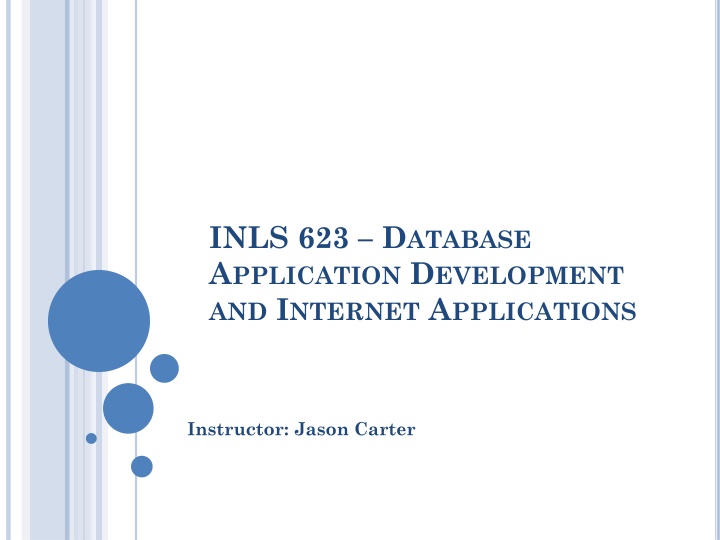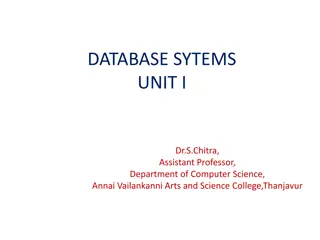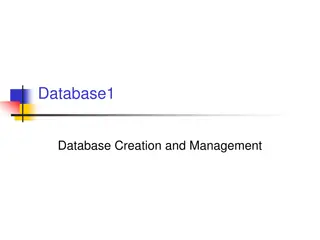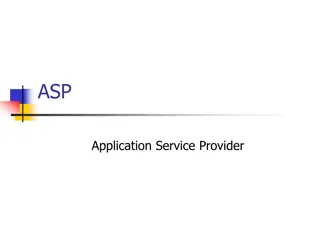INLS 623 Database Application Development and Internet Applications
"Why Internet applications? SQL, a query language, has limitations compared to typical programming languages which support complex computation, specialized user interfaces, logic and decision making, and access to multiple databases. Explore the Internet technologies including HTTP, client-server communication, and various programming languages. Understand the significance of HTTP, the dominant protocol on the Internet, for retrieving web documents. Dive into client-server interactions, HTTP requests and responses, and the basics of Internet communication."
Download Presentation

Please find below an Image/Link to download the presentation.
The content on the website is provided AS IS for your information and personal use only. It may not be sold, licensed, or shared on other websites without obtaining consent from the author.If you encounter any issues during the download, it is possible that the publisher has removed the file from their server.
You are allowed to download the files provided on this website for personal or commercial use, subject to the condition that they are used lawfully. All files are the property of their respective owners.
The content on the website is provided AS IS for your information and personal use only. It may not be sold, licensed, or shared on other websites without obtaining consent from the author.
E N D
Presentation Transcript
INLS 623 DATABASE APPLICATION DEVELOPMENT AND INTERNET APPLICATIONS Instructor: Jason Carter
WHY INTERNET APPLICATIONS? SQL is a query language; as such it has limitations Typical programming languages support: Complex computation on data Specialized user interfaces. Logic and decision making. Access to more than one database at a time
INTERNET HTTPRequest Response GET POSTRedirect HTML Java JavaScript AJAX PHP SQL ASP.NET CSS Python Cookies
INTERNET Server Client HTTPRequest Response GET POSTRedirect HTML Java JavaScript AJAX PHP SQL ASP.NET CSS Python Cookies
HTTP The HyperText Transport Protocol is the set of rules to allow browsers to retrieve web documents from servers over the Internet
HTTP - HYPERTEXT TRANSPORT PROTOCOL The dominant Application Layer Protocol on the Internet Invented for the Web - to Retrieve HTML, Images, Documents etc. Extended to be data in addition to documents - RSS, Web Services, etc.. Basic Concept - Make a Connection - Request a document - Retrieve the Document - Close the Connection http://en.wikipedia.org/wiki/Http
INTERNET Client Server HTTPRequest Response GET POSTRedirect HTML Java JavaScript AJAX PHP SQL ASP.NET CSS Python Cookies
CLIENT http://www.dr-chuck.com/page1.htm protocol host document
CLIENT/SERVER Server Client
CLIENT/SERVER Server Client Click
CLIENT/SERVER Server Request GET http://www.dr-chuck.com/page2.htm Client Click
CLIENT/SERVER Server Response Request <h1>The Second Page</h1><p>If you like, you can switch back to the <a href="page1.htm">First Page</a>.</p> GET http://www.dr-chuck.com/page2.htm Client Click
CLIENT/SERVER Server Response Request <h1>The Second Page</h1><p>If you like, you can switch back to the <a href="page1.htm">First Page</a>.</p> GET http://www.dr-chuck.com/page2.htm Client Click
Browser Web Server Database Server Apache MySql PHP
WHY PHP? Easy to learn MySQL is built into PHP PHP allows you to connect to and manipulate mysql databases. Works great with HTML PHP and HTML are interchangeable
PHP PHP: Personal Home Page PHP: Hypertext Preprocessor
SAMPLE PHP <h1>Hello from Dr. Chuck's HTML Page</h1> <p> <?php echo "Hi there.\n"; $answer = 6 * 7; echo "The answer is $answer, what "; echo "was the question again?\n"; ?> </p> <p>Yes another paragraph.</p>
SAMPLE PHP <h1>Hello from Dr. Chuck's HTML Page</h1> <p> <?php echo "Hi there.\n"; $answer = 6 * 7; echo "The answer is $answer, what "; echo "was the question again?\n"; ?> </p> <p>Yes another paragraph.</p>
INTERPRETED LANGUAGES Interpreter reads code and performs operations one line at a time. Machine Language PHP Interpeter
VARIABLES A variable is a name that refers to a value A name that represents a value stored in the computer memory Dollar signs to start variable names $age Assignment statement: used to create a variable and make it reference data General format is variable = expression Example: $age = 29 Assignment operator: the equal sign (=)
ASSIGNMENT STATEMENT In an assignment statement, variable receiving value must be on left side You can only use a variable if a value is assigned to it $message = "What s up, Doc? ; $n = 17; $pi = 3.14159;
STATEMENT A statement is an instruction that the PHP interpreter can execute echo 1 ; $x = 2; echo $x; Output: 1 2 The assignment statement does not produce output. All statements must end with a semicolon ( ; )
EXPRESSIONS A combination of values, variables, and operators Operators are special symbols that represent computations Addition Subtraction Division Multiplication Exponentiation Raises a number to a power x ** y = ?? Remainder (Modulus) Performs division and returns the remainder 4%2=0, 5%2=1 Typically used to convert times and distances, and to detect odd or even numbers Evaluate the expression: 4 + 4 Output: ? Evaluate the expression: (4 + 4) - 3 + / * ** %
EXPRESSIONS A combination of values, variables, and operators Operators are special symbols that represent computations Addition Subtraction Multiplication Division Reminder (Modulus) Performs division and returns the reminder 4%2 = 0 5%2 = 1 + - * / %
ORDEROF OPERATIONS Follows same rule of precedence as mathematics PEMDAS Parentheses Exponentiation Multiplication and Division Addition and Subtraction Evaluate the expression: (4 + 4) - 3
PHP ARRAYSAND MYSQL Stores items in a sequence one after another Stores multiple values in a single variable PHP retrieves records from a MySQL database table and stores them in an array Stores multiple values in a single variable
PHILOSOPHYOF PHP You are a responsible and intelligent programmer You know what you want to do Lets make this as convenient as possible Sometimes errors fail silently
CONNECTINGTO MYSQL <?php $servername = "pearl.ils.unc.edu"; $username = "db2_1"; $password = "hw3Mk4xgT"; $dbname = "db2_1"; // Create connection $conn = new mysqli($servername, $username, $password, $dbname); // Check connection if ($conn->connect_error) { die("Connection failed: " . $conn->connect_error); } ?>
SELECTINGFROMATABLE <?php $servername = " pearl.ils.unc.edu"; $username = " db2_1"; $password = " hw3Mk4xgT"; $dbname = db2_1"; // Create connection $conn = new mysqli($servername, $username, $password, $dbname); if ($conn->connect_error) { die("Connection failed: " . // Check connection $conn->connect_error); $sql = "select * from people"; $result = $conn->query($sql); } ?>
$conn = new mysqli($servername, $username,$password, $dbname); if ($conn->connect_error) { die("Connection failed: " . // Check connection $conn->connect_error); //if the number of rows are greater than 0 if ($result->num_rows > 0) { $sql = "select * from customers"; $result = $conn->query($sql); //while there are rows while($row = $result->fetch_assoc()) { echo $row[ pid']." ".$row[ first_name']." ".$row[ last_name']." ".$row[ user_name']; echo "<br />"; echo "<br /> ; } } } //close the connection mysqli_close($conn); ?>
CONNECTINGTO MYSQL <?php $servername = "pearl.ils.unc.edu"; $username = "db2_1"; $password = "hw3Mk4xgT"; $dbname = "db2_1"; // Create connection $conn = new mysqli($servername, $username, $password, $dbname); // Check connection if ($conn->connect_error) { die("Connection failed: " . $conn->connect_error); } ?>
INSERTING DATA <?php //variables that will be inserted into the database $courseNumber= 123; $sectionNumber = 23; $name= Databases III"; ?>
<?php $sql = "insert into course (courseNumber, sectionNumber, name) values ($courseNumber,$sectionNumber, '$name')"; //execute the query result = $conn->query($sql); ?>
<?php if($result) { echo "New record created successfully"; } else { echo "Error: " . $sql . "<br>" . mysqli_error($conn); } mysqli_close($conn); ?>
INSERTING DYNAMIC DATA Use HTML forms to collect data <form> </form> Form tags contain html elements There are many html elements Input Text Radio submit
INPUT TEXT TAGS <form> First name:<br> <input type="text" name="firstname"> <br> Last name:<br> <input type="text" name="lastname"> </form>
INPUT SUBMIT TAG <form action="action_page.php"> First name:<br> <input type="text" name="firstname" value="Mickey"> <br> Last name:<br> <input type="text" name="lastname" value="Mouse"> <br><br> <input type="submit" value="Submit"> </form>
SUBMIT Sends the values of the input tag (not the submit button) to the server The action tag determines which file processes the values from the input tag <form action="action_page.php"> How?
PASSVALUESTO SERVER/PHP GET (default) form submission is passive (like a search engine query), and without sensitive information GET is best suited to short amounts of data. Size limitations are set in your browser action_page.php?firstname=Mickey&lastname=Mouse <form action="action_page.php method= GET >
PASS VALUESTO SERVER/PHP POST form is updating data, or includes sensitive information (password) POST offers better security because the submitted data is not visible in the page address <form action="action_page.php" method="POST">
HOWDOES PHP GET THE VALUES? Superglobals Built in variables that are available at all scopes $GLOBALS $_SERVER $_REQUEST $_POST $_GET $_FILES $_ENV $_COOKIE $_SESSION
PHP $_POST Collects form data after submitting the HTML from using post <form action="action_page.php method = POST > First name:<br> <input type="text" name="firstname" value="Mickey"> <br> Last name:<br> <input type="text" name="lastname" value="Mouse"> <br><br> <input type="submit" value="Submit"> </form> echo $_POST[ firstname ]; echo $_POST[ lastname ];
PHP $_GET Collects form data after submitting the HTML from using post <form action="action_page.php method = GET > First name:<br> <input type="text" name="firstname" value="Mickey"> <br> Last name:<br> <input type="text" name="lastname" value="Mouse"> <br><br> <input type="submit" value="Submit"> </form> echo $GET[ firstname ]; echo $GET[ lastname ];
PRACTICE/HOMEWORK Look at homework























